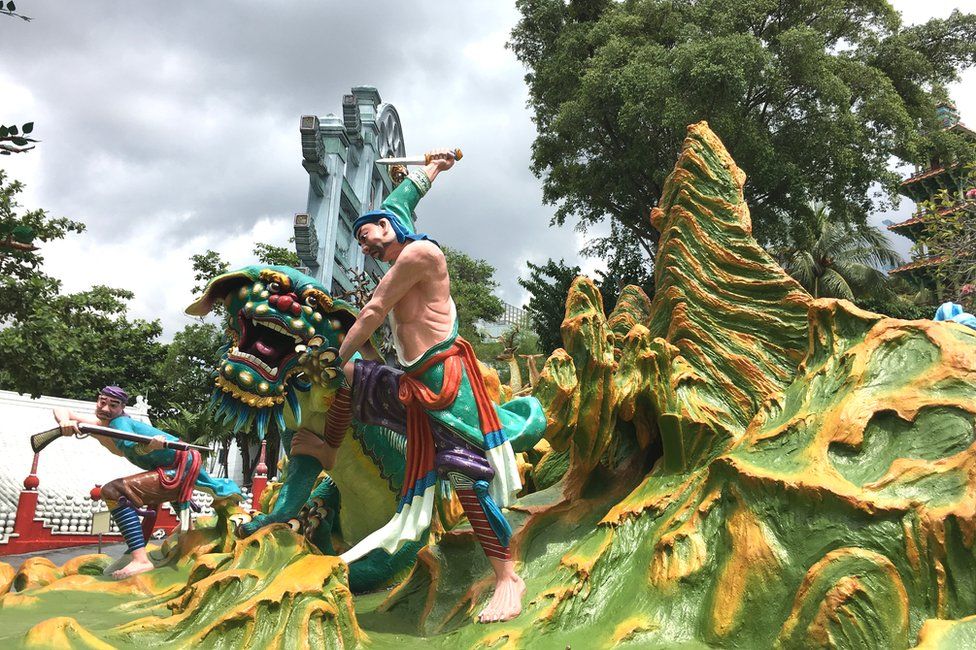The last artisan at Singapore's strangest theme park
- Published

With its sprawling collection of surreal and gruesome statues depicting Chinese folklore and mythology, Haw Par Villas has given generations of Singaporean schoolchildren nightmares.
Parents used to bring their children to the park as a rite of passage, to see what fate was in store for them in the afterlife if they stole, lied, or failed to respect their elders.
Depictions of a drug addict being tied to a red hot pillar and grilled, a rumour monger having his tongue pulled out, a tax dodger being pounded by stones, or an old woman suckling from her daughter-in-law while her baby cries - the ultimate display of filial piety - are all on display.
And every bit as much of a fixture is Teo Veoh Seng, the artisan who has looked after the statues for 70 years.
Watch: Teo Veoh Seng has looked after the statues in the park for 70 years
High on the park's steep hill, Mr Teo is carefully painting feathers on a giant cement bird, an upright turtle wearing a jester's hat riding on its back.
Nearby a cluster of brightly coloured life-sized topless mermaids lounge under the baking sun.
Crouching to mix colours from his vibrant selection of paints, he then hoists himself up onto wooden scaffolding twice his height.
It's hot and humid, but Mr Teo barely breaks a sweat.
"I'm 82 years old and I have been working at Haw Par Villa for 68 years," says Mr Teo.
He's one of a long line of family members who've been artisans at the park since it was built in 1937 by two tycoons from Myanmar (also known as Burma).
Aw Boon Haw and his brother Aw Boon Par developed the herbal ointment Tiger Balm, but they also had a philanthropic streak. Haw Par Villa was their gift to the people of Singapore.
Mr Teo's relatives found jobs building the park, and the Aw brothers also gave the family space inside to build themselves a house.
He was born in that house. The park, with its bizarre and macabre statues, was his backyard and playground.
"Haw Par Villa has a reputation for being scary but I've never seen anything frightening."
"As a young boy, I used to play in the park until seven or eight at night and got home only when the sky turned dark. Nothing strange has ever happened."
Statues' keeper
In 1948, when he was just 13 years old, Mr Teo started work learning the art of creating and maintaining the park's strange sculptures and figurines.
It was a job his father and his uncles did, and his grandfather and grand-uncles too.
And still now, five days a week, every week of the year, Mr Teo can be found chiselling away at a statue's cement casing, before delicately painting it with fine brush strokes.
Armed with his brush, his small tin cans of paint, and his old-fashioned tools, Mr Teo repairs and repaints every one of the park's hundreds of statues each year.
"One reason I've stayed in the job so long, is that I don't need to travel to work," he says.
"I also enjoy quite a bit of freedom in what I do. I start my work early in the morning around seven o'clock when it's still cool, and I rest in the afternoon to avoid the hot sun. I start working again when the weather gets cooler and I usually work until nightfall."
Solitary work
He used to work with a small team of artisans but they have all died, and Haw Par Villa has struggled to replace them.
Mr Teo says his children had no interest in following in his footsteps. The wages are low and the work is arduous.
"I have seven daughters and one son. Why would they want to work here? All of my children got a better education than I did and they either chose to go into business or work with big companies.
"They're paid better and they don't have to work under the hot sun," he says.
Now he has just one apprentice, 48-year-old Chen Jinlong, who was recruited from China five years ago.
Fading glory
In its heyday Haw Par Villa was estimated to attract a million visitors a year. These days just 200,000 people pass through its gates annually.
"In the old days, the crowds here were bigger because there weren't many interesting places to visit in Singapore. There used to be only Haw Par Villa and the Botanic Gardens," says Mr Teo. "Now there's the zoo, the bird park and many other places to go."
"This place is considered old and rundown," says Mr Teo.
But it still has nostalgic value for Singaporeans, and the tourism board is funding a major refurbishment starting later this year.
For now, the park might be tired but Mr Teo is not. The sprightly octogenarian says he has no plans to retire.
"I will continue to work because I'm still able to. Also I feel happy in my job. When I see a broken statue I feel it's a waste to leave it like that. I want to fix it."